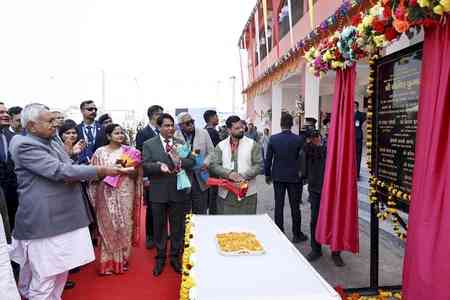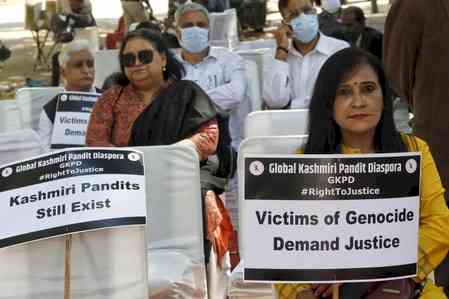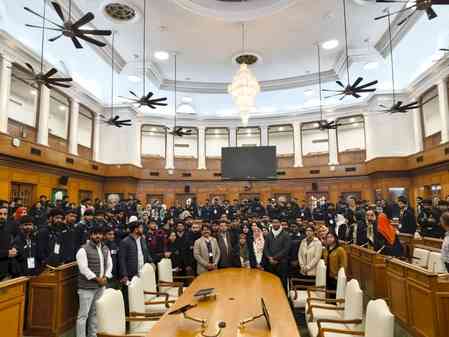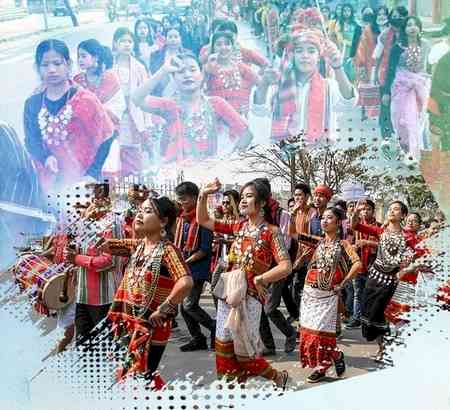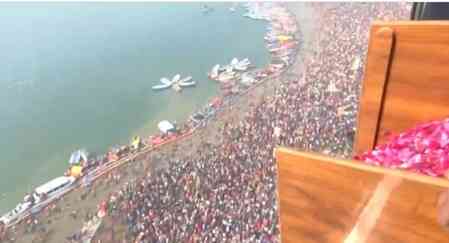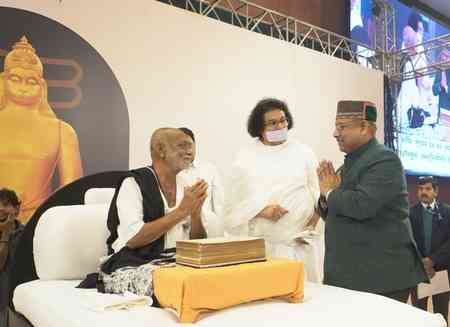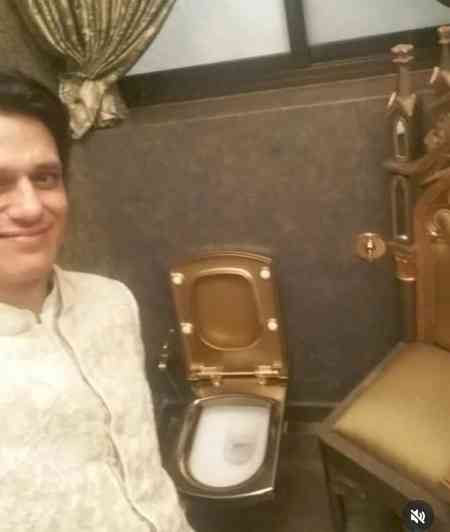Big challenge for BJP in 2022 to save Guj & win UP again
2022 is going to be a year of hopes and challenges for the Bharatiya Janata Party (BJP), which claims to be the world's largest party in terms of membership. In the new year, on one hand the party will have to work hard to save its stronghold Gujarat, while on the other hand winning the Uttar Pradesh Assembly elections again also comes as a big challenge.
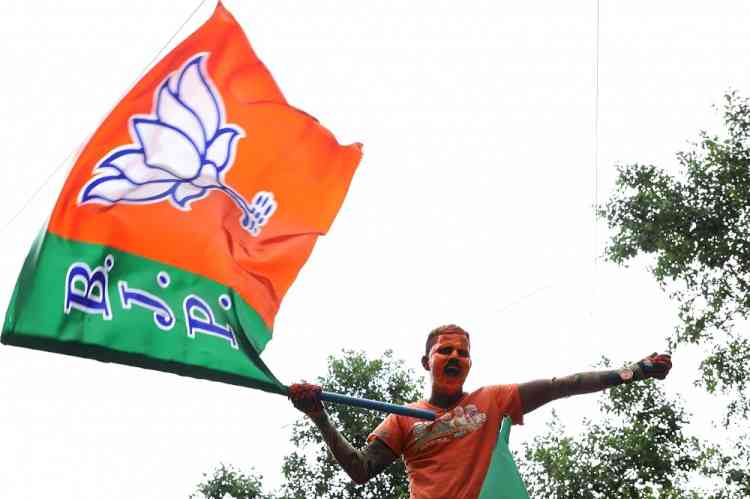
By Santosh Kumar Pathak
New Delhi, Dec 25 (IANS) 2022 is going to be a year of hopes and challenges for the Bharatiya Janata Party (BJP), which claims to be the world's largest party in terms of membership. In the new year, on one hand the party will have to work hard to save its stronghold Gujarat, while on the other hand winning the Uttar Pradesh Assembly elections again also comes as a big challenge.
The results of the Assembly elections to be held in seven states early next year, including Gujarat and Uttar Pradesh -- that sends maximum MPs to the Lok Sabha -- will indicate whose government will come to power at the Centre in 2024. Thus, 2022 can also be termed as the year for predicting 2024.
While elections in Uttar Pradesh, Uttarakhand, Punjab, Manipur and Goa are likely to be held in the early months of 2022, voting in Gujarat and Himachal Pradesh are likely towards the end of the year.
In 2022, the BJP will also be attempting to achieve its goal of an all-India expansion, which the party has been striving for since 1980.
The BJP will continue to make efforts to strengthen its organisation in the southern states of Kerala, Andhra Pradesh, Telangana and Tamil Nadu.
*Saving its stronghold Gujarat - the biggest challenge for BJP in 2022
The Legislative Assembly elections in Gujarat, the state which has remained a stronghold of the BJP for the last several decades, will be held in the last months of 2022. Being the home state of Prime Minister Narendra Modi and Home Minister Amit Shah, the election resultare directly associated with the prestige of both, so defending the state in 2022 is going to be a big 'challenge' for the BJP.
The term 'challenge' is being used as the BJP could barely save its government in the state in the 2017 Assembly elections. The BJP has been in power in Gujarat since 1995. After Modi became the Chief Minister n 2001, the BJP became invincible in the state. But in 2014 after Modi became the Prime Minister, the BJP has not been able to manage Gujarat so well.
In the five consecutive Assembly elections of 1995, 1998, 2002, 2007 and 2012, the BJP has been forming the government by winning between 115 and 127 seats out of the total 182 seats in the state. But in 2017, the tally fell below 100 as won only 99 seats. The Congress had won 77 seats in that election.
Talking about the voting percentage, the BJP got the support of 49 per cent voters, while the Congress secured 41.5 per cent of the ballots.
After the setback in its stronghold, the BJP changed the entire cabinet along with the Chief Minister. Now the biggest challenge before the BJP is to again win over 115 seats in the upcoming polls. Victory will ensure a seventh consecutive term for the saffron party-led government in the state.
* Winning Uttar Pradesh again
Uttar Pradesh, the country's largest state in terms of Lok Sabha seats, remains crucial for the BJP and especially for the Modi-Shah duo.
In 2013, when it was decided that the then Gujarat Chief Minister Narendra Modi would be the BJP's prime ministerial candidate in the 2014 general elections, he managed to place his most trusted ally Shah as the national general secretary in the team of the then party national president Rajnath Singh. Shah was also given the charge of Uttar Pradesh.
Later Modi opted Varanasi as his constituency to contest the Lok Sabha elections, this itself signified the importance of Uttar Pradesh for the BJP and the duo.
The state has a total of 403 seats in the Legislative Assembly and in the 2017 election results, the BJP along with its allies won 325 seats. The BJP alone won 312 seats with a vote share of around 40 per cent, while its ally Apna Dal (S) won nine and Om Prakash Rajbhar's SBSP garnered four.
In 2017, Samajwadi Party (SP) had won 47 seats with 21.82 per cent votes and Bahujan Samaj Party won 19 seats with 22.23 per cent votes.
The opposition, especially SP chief Akhilesh Yadav, is trying to change the political atmosphere of the state ahead of the much-awaited polls. Rajbhar, who contested the 2017 elections with the BJP, is with the SP this time and Akhilesh is trying his best to break the caste equations of the saffron party.
It is said that "the path to the throne of Delhi passes through Uttar Pradesh", and therefore the BJP does not want to lose the state, which sends the maximum 80 MPs to the Lok Sabha, so in 2022, repeating its 2017 perforfamce would be one of the biggest challenges for the BJP.
* After three Chief Ministers in five years, winning Uttrakhand again, another challenge for the BJP
Since the formation of Uttarakhand, the people of the state have not given a mandate to the government of any one party for a second time in a row. Breaking this trend, forming the government consecutively for the second time is another big task for the BJP in 2022.
In the 2017 Legislative Assembly elections, the BJP won 56 seats with 46.5 per cent votes while contesting on all 70 seats in the state. Intrestingly, the Congress had won just 11 seats in the assembly polls despite getting 33.5 per cent votes.
Seeing the mood of the people of the state, BJP had to change its Chief Minister thrice within five years.
After winning the election in 2017, it made Trivendra Singh Rawat the Chief Minister. In March 2021, he was replaced by Tirath Singh Rawat and after a few months the command of the state was handed over to Pushkar Singh Dhami. The BJP's main rival in Uttarakhand is the Congress, and by winning again, it wants to send a message that revival of the latter in 2024 is difficult.
* Challenge to prove popularity in the northeast by winning Manipur again
To prove its popularity in the northeast, the BJP is aiming to form a government in Manipur once again.
In the 2017 polls in Manipur, the BJP had won only 21 seats out of the total 60, while the Congress got 28 seats. The difference of votes between the two was less than 1 per cent. But with the help of other parties, the BJP formed the government for the first time in Manipur and ran it for five years. Now depending on the works of its government and the popularity of Prime Minister Modi, the BJP again wants to bloom in this northeastern state.
* Making a hat-trick in Goa, the BJP's goal
In 2022, the BJP wants to do a hat-trick by forming the government for a third time in Goa. Like Manipur, the BJP had won fewer seats than Congress in the coastal state in 2017, but with the help of other parties, the saffron party formed its government.
In the 2017 polls, out of the total 40 Assembly seats in the state, the maximum 17 (28.35 per cent of the votes) went to the Congress, while the BJP had secured victory over 13 seats despite getting a higher vote percentage (32.48).
However showing political readiness, BJP, for the second time, formed the government in the state with the support of other parties and ran it for the five years. This time BJP wants to form the government on its own by getting majority in the state. This small state with 40 seats is going to have an interesting political battle this time. The main contest maybe between the BJP and the Congress, but this time along with many old regional parties like Goa Forward Party and Maharashtrawadi Gomantak Party, many other parties including TMC, Aam Aadmi Party, Shiv Sena will be contesting the polls.
In this multi-cornered fight, the BJP is fully hopeful about winning Goa, but it is not less than a big challenge in itself for the BJP, which is going to contest the first election in the absence of late party veteran Manohar Parrikar in the state.
* Strenghtening the party's support base in Punjab
Among the states in which elections are going to be held in 2022, Punjab is also crucial.
However, the BJP, which will fight the polls on its own for the first time after separating from the Akali Dal in Punjab, has nothing to lose and a lot to gain in the state. The BJP is going to contest the Assembly elections in Punjab along with Amarinder Singh, who was the Chief Minister in the Congress government and former Akali Dal leader Sukhdev Singh Dhindsa.
The BJP is also well aware of the political situation in Punjab and therefore instead of making claims to form the government, the BJP leaders are seen saying that no government will be formed in the state without them.
However, at the same time, the BJP is 'treating' the state as 'sensitive' because of its border with Pakistan and is promising to the people of Punjab that only the BJP government can give security to Punjab.
The Punjab Legislative Assembly has a total of 117 seats.
In 2017, the BJP and Akali had contested the elections together. The Akali Dal contested 94 seats and won 15 with 25.24 per cent votes. Whereas the BJP, which contested on 23 seats, won only three with 5.39 per cent votes. Congress had formed the government in the state by winning 77 seats with 38.5 per cent votes. However Amarinder Singh, who became the Chief Minister at the time, is now forming a new party and is going to contest the elections with the BJP in 2022.
* Goal to secure second term in Himachal Pradesh
Like Uttrakhand, in the hill state of Himachal Pradesh too, since 1990, no government has got a mandate for the second time in a row. It is a big challenge for the BJP to break this trend in the state and form the government for the second time in 2022.
In 2017, the BJP, which contested on a total of 68 seats in the state, won 44 with 48.79 per cent of the votes. At the same time, 21 seats came in the account of Congress with 41.68 per cent votes.
The recent by-elections in the state have raised the concerns of the BJP high command and it is also fully aware of the fact that a 'lot' needs to be done to regain the mandate of the people of the state.


 IANS
IANS 
